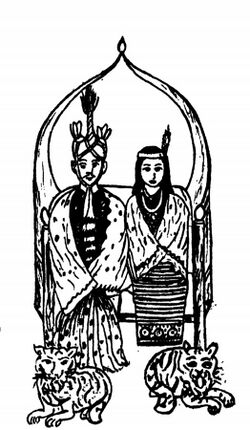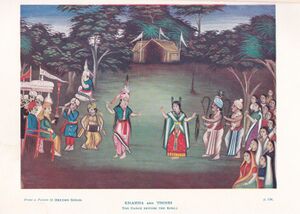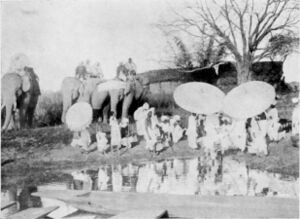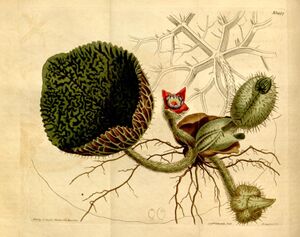Religion:Thangching
| Thangching | |
|---|---|
Progenitor of the Moirang clan | |
| Member of Lainingthous, Maikei Ngaakpa Lais and Umang Lais | |
 | |
| Other names | Thangjing |
| Affiliation | Meitei mythology (Manipuri mythology) and Meitei religion (Sanamahism) |
| Major cult center | Moirang |
| Abodes | Heaven and Earth[1] |
| Weapon | Polo stick |
| Animals | White tiger and horse |
| Mount | White tiger and horse |
| Texts | Moirang Ningthourol Lambuba |
| Gender | Male |
| Region | Moirang |
| Ethnic group | Meitei ethnicity |
| Festivals | Lai Haraoba |
| Consorts | Ayangleima Ahal, Ayangleima Atompi |
| Term | |
|---|---|
| English | Thangching |
| Ancient Meitei | ꯊꯥꯡꯆꯤꯡ (thaang-ching) |
| Modern Meitei | ꯊꯥꯡꯖꯤꯡ (thaang-jing) |
| Assamese | থাংচীং / থাংচিং (thaang-ching) |
| Bengali | থাঙচীঙ / থাঙচিঙ (thaang-ching) |
| Hindi | थांचीं (thaang-ching) |
| Sanamahism | |
Thangching or Thangjing is a primordial deity in Meitei mythology and religion of Ancient Kangleipak (Antique Manipur). He is the ruling deity of the Moirang dynasty of Ancient Moirang.[2][3][4][5] He rules supreme on the banks of the landlocked sea, Loktak lake.[6][7] He is one of the four cardinal Umang Lais.[8] The guardianship of the south western direction is alluded to Thangjing and the other directions to Koubru (north west), Marjing (north east) and Wangbren (south east).[8][9][10][11]
Two of his most prominent pantheons are the Thangching Temple and the Thangching Hill (Thangjing Peak).[12][13]

Origin
God Thangjing is a deity of pre-Hindu origin.[14][15][16][17][18] The Moirang Ningthourol Lambuba mentioned that Moirang was the amalgamation of different groups of people with different traditional beliefs. During the reign of King Fang Fang Ponglenhanpa (52 BC- 28 AD), all the diversities were merged into one with God Thangjing as the central figure.[19]
When the cult of God Thangjing was merged into the Umang Laism, the folk deities associated with God Thangjing began to be identified with other Umang Lais. One example is that of goddess Ayang Leima Ahal and goddess Ayang Leima Atonpi. These two goddesses were originally associated with fertility and agriculture. This fact is evident in the ritualistic songs praising them. Later, these two female deities were identified as the consorts of God Thangjing.[19]
When God Thangjing was identified as an Umang Lai, the identity of the two goddesses was associated with that of goddess Panthoibi. Thus, the new identity of Goddess Ayang Leima Panthoibi was formed.[19]
Description
Thangjing is described as the Lord of the tiger hunters.[11] The Moirang Ningthourol Lambuba describes God Thangjing as the Divine Chief of Koireng people, the Progenitor of Kege Clan, the Protector of all the domestic as well as wild animals and the Lord of Mahui tribe.[19]

The history of Moirang is always associated with the godly powers of Thangjing. Thangjing is a living God to the people of Ancient Moirang. The epic legend of the Khamba Thoibi is always related to God Thangjing. The ancient temple dedicated to Thangjing still stands on the banks of Loktak lake in the present day Moirang.[3][11]
Mythology
In the legendary epic Khamba Thoibi, Lord Thangjing always stands for righteousness and as a saviour of Khamba.[20]
Thangjing sent Phouoibi to Kege Moirang (Keke Moilang) to prosper the human world.[7]
When goddess Panthoibi was searching for her beloved Nongpok Ningthou, she asked God Thangjing and God Wangbren about the whereabouts of Nongpok Ningthou. To Thangjing, she said:
O! Thangjing, Supreme God of Moirang, Loktak is your mirror, My beloved Nongpok has gone like a wind, Like a cattle looking for its herd, I am looking for my beloved. Please tell me Does he come to your country?[21]
Worship

Thangching had been worshipped since ancient times. Still today, there is an ancient shrine at Moirang. An annual ritual festival known as Thangjing Haraoba is held early in summer in honor of the God.[22][23] During the annual Thangjing Lai Haraoba festival, traditional dances and sports are performed as rituals. The performers follow the ancient customs of wearing the traditional attires of the royal lords and ladies.[16][17][24] The festival is celebrated during the Meitei lunar month of Kalen. It continues for a week.[25] Meiteis from all over Manipur visit the Thangjing Temple in Moirang.[26]
Namesakes
In flora

The Thangjing plant (Euryale ferox) is an aquatic plant that bears edible seeds. Its seeds are called "foxnuts" and are one of the most popular food items in Meitei cuisine of Manipur.[27][28]
In geography
The Thangching Peak (Thangjing Hill) is one of the four peaks, the others being the Koubru (after God Koubru), the Kounu (after Goddess Kounu) and the Loyalakpa (after God Loyalakpa). These peaks are the holy places of worship of the Meitei ethnicity. Their names are derived from the names of the deities whom the Meiteis worship at the peaks.[12]
See also
- Koupalu (Koubru) - north west protector
- Marjing - north east protector
- Wangbren - south east protector
References
- ↑ Roy, L. Somi (2021-06-21) (in en). And That Is Why... Manipuri Myths Retold. Penguin Random House India Private Limited. ISBN 978-93-91149-65-9. https://books.google.com/books?id=XxovEAAAQBAJ&q=Thangjing%2C+the+guardian+god+of+Moirang%2C+saw+from+the+heavens+&pg=PT53.
- ↑ "The God Lainingthou Thangching Koylellai". https://www.thesangaiexpress.com/Encyc/2021/2/5/Dr-Mangangcha-Thoudam-Laiba-Contd-from-previous-issueIt-is-called-Yai-The-place-is-called-Kanglei-Pungmayol-because-of-it-being-the-residence-of-the-two-Supreme-God-and-Goddess-it-is-called-Ma.amp.html.
- ↑ 3.0 3.1 Prakash, Col Ved (2007) (in en). Encyclopaedia of North-East India. Atlantic Publishers & Dist. ISBN 978-81-269-0706-9. https://books.google.com/books?id=wxkC9S2jYCkC&dq=He+ruling+deity+Moirang+dynasty+history+Moirang+woven+around+divine+power+this+deity+citizens+Moirang+Lord+Thangjing+living+God+khamba+thoibi+relation+temple+Loktak+lake+Moirang&pg=PA1557.
- ↑ Chaudhury, Dipanjan Roy (2008) (in en). Northeast: Diverse Complexity. Har-Anand Publications Pvt. Limited. ISBN 978-81-241-1437-7. https://books.google.com/books?id=-SO7stGa7jQC&q=God+-+Thangjing+ruling+deity+Moirang+&pg=PA107.
- ↑ Roy, L. Somi (2021-06-21) (in en). And That Is Why... Manipuri Myths Retold. Penguin Random House India Private Limited. ISBN 978-93-91149-65-9. https://books.google.com/books?id=XxovEAAAQBAJ&q=Thangjing%2C+the+guardian+god+of+Moirang%2C+saw+from+the+heavens+&pg=PT53.
- ↑ Singh, N. Tombi (1975) (in en). Manipur and the Mainstream. Chitrebirentombichand Khorjeirup. https://books.google.com/books?id=Qs4BAAAAMAAJ&q=thangjing+loktak+bank.
- ↑ 7.0 7.1 Session, North East India History Association (1999) (in en). Proceedings of North East India History Association. The Association. https://books.google.com/books?id=vDduAAAAMAAJ&q=Lord+Thangjing+made+incarnated+moirang+.
- ↑ 8.0 8.1 Birajit, Soibam (2014-12-01) (in en). Meeyamgi Kholao: Sprout of Consciousness. ARECOM ( Advanced Research Consortium, Manipur). pp. 81. https://books.google.com/books?id=PgHgCwAAQBAJ&dq=thangjing&pg=PA81.
- ↑ Dzüvichü, Lipokmar; Baruah, Manjeet (2017-11-13) (in en). Modern Practices in North East India: History, Culture, Representation. Taylor & Francis. ISBN 978-1-351-27134-9. https://books.google.com/books?id=C2Q-DwAAQBAJ&q=guardianship+of+the+four+respective+directions+alluded+to+the+Gods+%E2%80%93+Thangjing+for+south%E2%80%93west&pg=PT355.
- ↑ (in en) Socialist India. Indian National Congress. All India Congress Committee.. 1973. https://books.google.com/books?id=z8xoJo-GQUIC&q=Thangjing+south+-+west&pg=RA13-PA15.
- ↑ 11.0 11.1 11.2 Chaki-Sircar, Manjusri (1984). Feminism in a traditional society : women of the Manipur Valley. Shakti Books. pp. 116. ISBN 9780706919677. https://archive.org/details/feminismintradit0000chak/page/116/mode/2up?q=Thangjing+southwest+lord+tiger+hunters+moirang+southwestern+khamba+thoibi+temple+thang+jing.
- ↑ 12.0 12.1 Singh, Dr Th Suresh (2014-06-02) (in en). The Endless Kabaw Valley: British Created Visious Cycle of Manipur, Burma and India. Quills Ink Publishing. ISBN 978-93-84318-00-0. https://books.google.com/books?id=kbu_AwAAQBAJ&q=From+North+to+South%2C+Koubru%2C+Kounu%2C+Loyalakpa%2C+Thangjing+are+four+peaks.+These+four+peaks+are+places+of+worship+of+the+Meitei+race+and+the+names+of+the+peaks+are+given+by+the+names+of+the+gods+whom+the+Meeteis+worship+at+the+peaks.&pg=PA11.
- ↑ "The God Lainingthou Thangching Koylellai". http://e-pao.net/epSubPageExtractor.asp?src=manipur.Manipur_and_Religion.The_God_Lainingthou_Thangching_Koylellai_By_Mangangcha_Thoudam.
- ↑ Singh, A. Prafullokumar (2009) (in en). Elections and political dynamics. Mittal Publications. ISBN 978-81-8324-279-0. https://books.google.com/books?id=b3TwS0WRn5kC&q=Thangjing+God+presiding+pre+-+Hindu+deity&pg=PA17.
- ↑ Laveesh, Bhandari (2009) (in en). Indian States At A Glance 2008-09: Performance, Facts And Figures - North-East And Sikkim. Pearson Education India. ISBN 978-81-317-2348-7. https://books.google.com/books?id=pth_7qgEN7IC&q=pre+-+Hindu+Thangjing&pg=PA28.
- ↑ 16.0 16.1 Singh, Arambam Sanatomba (2021-06-18) (in en). Ecotourism Development Ventures in Manipur: Green Skill Development and Livelihood Mission. Walnut Publication. ISBN 978-93-91145-59-0. https://books.google.com/books?id=7YQ8EAAAQBAJ&q=ancient+temple+of+the+pre-Hindu+deity%2C+Lord+Thangjing+Koirel+Lai+%28sacred+groves+of+Moirang+Thangjng%29+is+situated+here.+In+the+month+of+May%2C+men+and+women%2C+dressed+in+colourful+traditional+costumes+sing+and+dance&pg=PA72.
- ↑ 17.0 17.1 Kohli, M. S. (2002) (in en). Mountains of India: Tourism, Adventure and Pilgrimage. Indus Publishing. ISBN 978-81-7387-135-1. https://books.google.com/books?id=GIs4zv17HHwC&dq=ancient+temples+pre+-+Hindu+deity+Thangjing+year+month+May+men+women+dressed+colourful+traditional+costumes+sing+dance+Moirang+Lai+Haraoba+ritual&pg=PA183.
- ↑ Darpan, Pratiyogita (2008) (in en). Pratiyogita Darpan. Pratiyogita Darpan. https://books.google.com/books?id=xegDAAAAMBAJ&q=ancient+temple+pre-Hindu+deity%2C+Lord+Thangjing&pg=PT90.
- ↑ 19.0 19.1 19.2 19.3 Birajit, Soibam (2014-12-01) (in en). Meeyamgi Kholao: Sprout of Consciousness. ARECOM ( Advanced Research Consortium, Manipur). pp. 82. https://books.google.com/books?id=PgHgCwAAQBAJ&dq=thangjing&pg=PA82.
- ↑ Singh, Rajkumar Mani (2002) (in en). Khwairakpam Chaoba Singh. Sahitya Akademi. ISBN 978-81-260-1519-1. https://books.google.com/books?id=d8jlWVP4uKsC&q=Looming+large+in+the+background+is+Lord+Thangjing+who+stands+for+righteousness+.+He+serves+as+saviour+of+Khamba+as+Lord+Krishna+did+for+the+Pandavas&pg=PA35.
- ↑ Meitei, Mayanglambam Mangangsana (2021-06-06) (in en). The Sound of Pena in Manipur. Marjing Mayanglambam. ISBN 978-93-5473-655-1. https://books.google.com/books?id=j7E2EAAAQBAJ&dq=thangjing&pg=PA77.
- ↑ Devi, Dr Yumlembam Gopi (in en). Glimpses of Manipuri Culture. Lulu.com. ISBN 978-0-359-72919-7. https://books.google.com/books?id=gxqeDwAAQBAJ&q=Even+Thangjing+had+been+worshipped+through+the+ages.+Even+to-day+there+is+a+shrine+at+Moirang+where+an+elaborate+ritual+festival+known+as+Thangjing+Haraoba+is+held+annually+early+in+summer&pg=PA20.
- ↑ Delhi, All India Radio (AIR), New (1967-12-03) (in en). AKASHVANI: Vol. XXXII, No.49 ( 3 DECEMBER, 1967 ). All India Radio (AIR),New Delhi. https://books.google.com/books?id=LXj2DwAAQBAJ&q=Moirang+is+also+the+abode+of+Thangjing%2C+the+most+venerated+deity.+Another+colourful+religious+dance%2C+Lai+Haraoba+is+celebrated+in+May+in+honour+of+Thangjing.+The+temple+HEART+OF+MANIPUR+of+Thangjing&pg=PA7.
- ↑ Singh, T. S. P. (2018-05-31) (in en). Apology. Partridge Publishing. ISBN 978-1-5437-0188-3. https://books.google.com/books?id=kMNiDwAAQBAJ&q=Every+year%2C+festivals+of+traditional+dances+and+sports+are+performed+as+rituals+during+Thangjing+Lai+Haraoba%2C+the+ancient+customs+of+the+royal+lords+and+ladies+wearing+traditional+attire+occupied+their+seats%2C+a+remnant+of+the+legend+of+Moirang+Leibak+Kingdom&pg=PT85.
- ↑ Gajrani, S. (2004) (in en). History, Religion and Culture of India. Gyan Publishing House. ISBN 978-81-8205-065-5. https://books.google.com/books?id=QQWMc7_qj4kC&dq=Moirang+Lai+-+Haraoba+celebrated+honour+Lord+Thangjing+month+kalen+continues+week&pg=PA167.
- ↑ Ghosh, G. K. (2002) (in en). Water of India: (quality and Quantity). APH Publishing. ISBN 978-81-7648-294-3. https://books.google.com/books?id=enE9kdIKqCQC&q=Meitheis+from+all+over+Manipur+visit+Moirang+because+of+all+important+Thangjing+temple&pg=PA75.
- ↑ "Thangjing". May 2016. https://medicinalplants.co.in/thangjing/.
- ↑ "Thangjing – A potential aquatic cash crop in Manipur". http://e-pao.net/epSubPageExtractor.asp?src=education.Science_and_Technology.Thangjing_A_potential_aquatic_cash_crop_in_Manipur_By_N_Irabanta.
External links
| Wikimedia Commons has media related to Thangching. |
